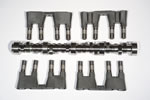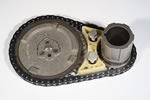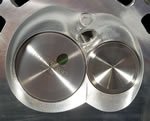Ruthless Pursuit of Power: The Mystique of the C6 Corvette LS7 Engine - Page 13 of 26
Ruthless Pursuit of Power: Lucky Seven Edition: The Mystique of the 7-Liter, 7000-RPM, LS7 - Page 13 of 26
 |
 |
by Hib Halverson
© May 2013— Updated: November 2014
No use without permission, All Rights Reserved
Cam and Valve Gear
LS7's valve train was yet another field on which GM Powertrain moved the technology ball forward for another first down. Not only does the LS7 have a hydraulic lifter valve train which runs to 7100 RPM, 500-RPM higher than that of the C5 Z06 engine and beyond the capability of even the solid lifter engines of the bygone Musclecar Era, but it has a huge, 2.20-in intake valve--the largest ever in a production GM V8, besting the 2.19 intake used in Big-Block V8s of 1965-1972. Valve lifts are an astonishing .593-in. and .589-in. for intake and exhaust, a significant leap past the '02-'04 LS6 camshaft, previously GM's most aggressive. Duration at .050-in. Lift jumped 6° to 210° on the intakes and a whopping 20° to 230° on the exhausts. While lift and duration are often cited in comparisons of cams, a more telling measurement is lift area which, when you graph the valve lift, is the area below the curve. With the LS7 cam, compared to LS6, lift area rose 12% on the intakes and 15% on the exhaust, both significant increases.
Camshaft Profile, Intake Comparison
(All lift figures are valve lift)
| year RPO |
int. lift |
int. dur. at .004 |
int. dur. at .050 |
int. open at .004 |
in. close at .004 |
in. open at .050 |
in. close at .050 |
int. CL |
int. area |
int. area increase |
|---|---|---|---|---|---|---|---|---|---|---|
| MY01 LS6 | 13.34 mm .525 in |
270° | 204° | 9° BTDC |
81° ABDC |
18 ATDC |
42 ABDC |
118° ATDC |
1862.9 mm/deg. |
-4% |
| MY02 LS6 | 14.01 mm .551 in |
267° | 204° | 7° BTDC |
80° ABDC |
19° ATDC |
43 ABDC |
120° ATDC |
1936.9 mm/deg. |
0 |
| MY05 LS2 | 13.34 mm .525 in |
270° | 204° | 9° BTDC |
81° ABDC |
18° ATDC |
42 ABDC |
118° ATDC |
1862.9 mm/deg. |
-4% |
| MY06 LS7 | 15.06 mm .593 in |
276° | 210° | 8° BTDC |
88° ABDC |
18° ATDC |
48° ABDC |
122° ATDC |
2166.4 mm/deg. | 12% |
Camshaft Profile, Exhaust Comparison
(All lift figures are valve lift)
year RPO |
exh. lift |
exh. dur. at. .004 |
exh. dur. .050 |
ex. open .004 |
ex. close .004 |
ex. open .050 |
ex. close .050 |
exh. CL |
exh. area |
ex. area change |
|---|---|---|---|---|---|---|---|---|---|---|
| MY01 LS6 | 13.33 mm .525 in |
275° | 211° | 65° BBDC |
30° ATDC |
37 BBDC |
6 BTDC |
114° BTDC |
1914.6 mm/deg. |
-8% |
| MY02 LS6 | 13.91 mm .547 in |
282° | 218° | 69° BBDC |
33° ATDC |
42 BBDC |
4 BTDC |
115° BTDC |
2046.6 mm/deg. |
0 |
| MY05 LS2 | 13.33 mm .525 in |
275° | 211° | 65° BBDC |
30° ATDC |
37 BBDC |
6 BTDC |
114° BTDC |
1914.6 mm/deg. |
-8% |
| MY06 LS7 | 14.95 mm .589 in |
296° | 230° | 81° BBDC |
35° ATDC |
53 BBDC |
3 BTDC |
119° BTDC |
2359.4 mm/deg. | 15% |
"The design philosophy on that cam is similar to the LS6, the ramp designs are very aggressive," Jim Hicks, who lead the LS7's valvetrain development, told us. "We were limited in what we could do with camshaft because you've got a cam bearing diameter and the nose can only go so high. We had to drop the base circle down to a smaller radius so the nose radius could be larger. In addition to that, we went to the higher rocker ratio and that gets us to the (valve) lift we needed. Then, we tried to make everything as light and as stiff as possible."
The higher rev limit, a gargantuan intake valve, more aggressive valve train velocities and a big increase in lift area required some trick valvetrain features previously reserved for racing applications. The first task was to reduce valvetrain mass. Inspired by Katech's C5-R 427s using a titanium intake valve, Hicks and the LS7 valvetrain engineers decided on a Ti intake and a hollow-stem exhaust valve as two ways to get the mass down. Despite a valve head which is 22% larger, the Ti intake weighs 19-grams less--a 21% reduction--than the smaller diameter and shorter stemmed, LS2 intake valve. The Ti intake valve, supplied by long-time titanium valve manufacturer, Del West Engineering, was the World's first application of the super-light metal in a production automotive valvetrain.
"We started with a hollow-stem, steel valve, kinda like the LS6, with a very thin head, "Hicks said. "We reached a point where the power the engine was making was flexing the valve head enough that we had problems with the valve heads cracking. Combustion pressure causes the valve head to flex. Imagine pushing on the top of a tin can, moving it in-and-out. If the section (thickness of the valve head) gets too thin relative to the amount of pressure in the chamber, you'll get this flexing and, eventually, a pie-shaped section breaks off. We found this with test engines. At the time, we were, also, doing some work with Katech. They were using a lot of our parts in the World Challenge, the first year of the Cadillac CTS-V program and they failed some of our valves, as well.
 |
 |


